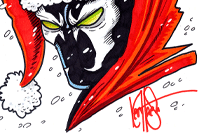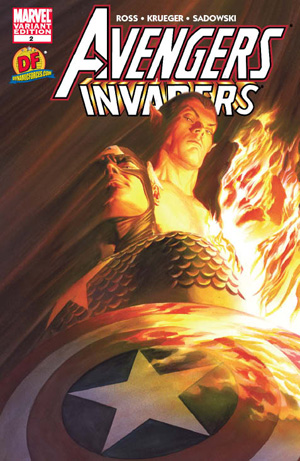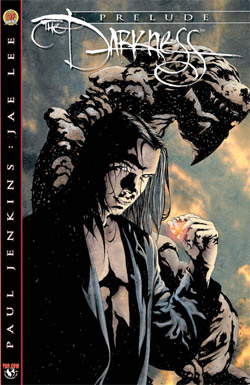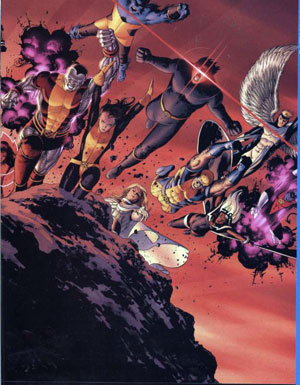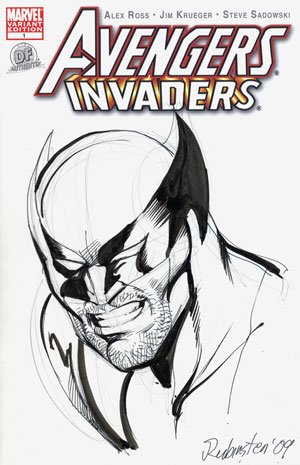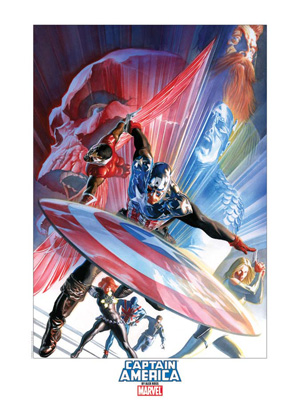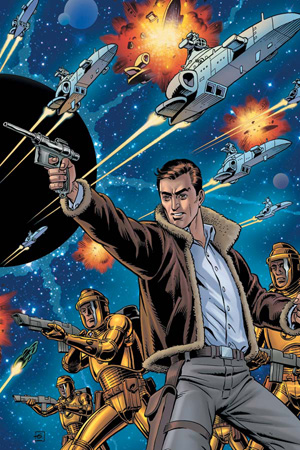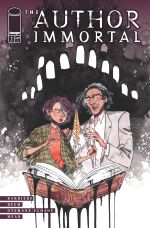|

|
CAPTAIN AMERICA Captain America, the alter ego of Steve Rogers, is a superhero in the Marvel Comics universe. Created by Joe Simon and Jack Kirby, he first appeared in Timely Comics' Captain America Comics #1 (March 1941). Often seen as a symbol of America's spirit, he has been associated with the Avengers since 1964, shortly after their formation, and is considered a founding member. Over the years, an estimated 210 million copies of "Captain America" comic books have been sold in a total of 75 countries. The character has been adapted for a movie serial, two made-for-television movies, one direct-to-video movie, and several animated properties.
Publication history
Captain America was one of the most popular characters of Marvel Comics (then known as Timely) during the Golden Age of Comic Books. Though preceded by MLJ's The Shield, Captain America immediately became the most prominent and enduring of a wave of patriotically themed superheroes introduced in American comic books prior to and during World War II. With his sidekick Bucky, Captain America faced Nazis, Japanese and other threats to wartime America and the Allies.
In the post-war era, with the popularity of superheroes fading, Captain America led Timely/Marvel's first superhero team, the All-Winners Squad, in its two published adventures. In his own series he turned his attention to criminals and Cold War Communists. After Bucky was shot and wounded in a 1948 story, he was succeeded by Captain America's girlfriend Betsy Ross, who became the superheroine Golden Girl. Captain America Comics ended with #75 (Feb. 1950), by which time the series had been titled Captain America's Weird Tales for two issues, with the finale a horror/suspense anthology issue with no superheroes.
Captain America was briefly revived, along with the original Human Torch and the Sub-Mariner, in Young Men #24 (Dec. 1953), published by Marvel's 1950s iteration Atlas Comics. Billed as "Captain America, Commie Smasher!", he appeared several times during the next year in Young Men and Men's Adventures, as well as in three issues of an eponymous title. Sales were poor, however, and the character again disappeared after Captain America #78 (Sept. 1954).
In the 1970s, the post-war versions of Captain America were retconned into separate, successive characters who briefly took up the mantle of Captain America after Steve Rogers went into suspended animation near the end of World War II.
In the Human Torch story titled "Captain America" in Marvel Comics' Strange Tales #114 (Nov. 1963), by Stan Lee and Jack Kirby, the brash young Fantastic Four member Johnny Storm, the Human Torch, engages in an exhibition performance with Captain America, depicted as a legendary World War II and 1950s superhero who has returned after many years of apparent retirement.
The 13-page story ends with this Captain America revealed as an impostor: the villain the Acrobat, a former circus performer the Torch had defeated in Strange Tales #106. Afterward, Storm digs out an old comic book in which Captain America is shown to be Steve Rogers. A caption in the final panel says this story was a test to see if readers would like Captain America to return.
He did so in The Avengers #4 (March 1964), which story explained that in the final days of WWII, Captain America fell from an experimental drone plane into the North Atlantic Ocean and spent decades frozen in a state of suspended animation. (Retellings sometimes place the event over the English Channel.) The hero found a new generation of readers as leader of the all-star superhero team the Avengers, and in a new solo feature beginning in Tales of Suspense #59 (Nov. 1964), a "split book" shared with the feature "Iron Man". The new Captain American stories were written by Stan Lee and generally penciled or laid out by Captain America's Golden Age co-creator, Jack Kirby. Gil Kane, in some of his earliest Marvel work, also drew some stories. The feature went to full-length and took over the numbering of Tales of Suspense with #100. (Iron Man received his own, separate series.) The new title Captain America continued to feature artwork by Kirby, as well as a short run by Jim Steranko, and work by many of the industry's top artists and writers.
This series - considered Captain America vol. 1 by comics researchers and historians, following the 1940s Captain America Comics and its 1950s numbering continuation - ended with #454 (Aug. 1996). It was almost immediately followed by the 13-issue Captain America vol. 2 (Nov. 1996 - Nov. 1997), the 50-issue Captain America vol. 3 (Jan. 1998 - Feb. 2002), the 32-issue Captain America vol. 4 (June 2002 - Dec. 2004) and Captain America vol. 5 (Jan. 2005 - ).
Fictional character biography
Steve Rogers is born on July 4, 1917 in the Lower East Side of Manhattan, New York City, to Irish immigrants Sarah and Joseph Rogers.By the early 1940s, before America's entry into World War II, Rogers is a tall (6 ft 2 in) but scrawny fine arts student specializing in illustration. Disturbed by the rise of the Third Reich, Rogers attempts to enlist, only to be rejected due to his poor constitution. A U.S. Army officer looking for test subjects offers Rogers the chance to serve his country by taking part in a top-secret defense project - Operation: Rebirth, which seeks to develop a means of creating physically superior soldiers. Rogers volunteers for the research and, after a rigorous selection process, is chosen as the first human test subject for the Super-Soldier serum developed by the scientist "Dr. Reinstein", later retroactively changed to a code name for the scientist Abraham Erskine.
Later stories reveal that Rogers is not the first to be given the Super-Soldier formula. The night before Rogers receives the Super-Soldier formula, some military members of the project decide that a non-soldier is not the right candidate and secretly give Erskine's incomplete formula to Clinton McIntyre. This, however, makes McIntyre violently insane, and he is subdued and placed in cold storage. The criminal organization AIM later revives McIntyre as the homicidal Protocide.
The night that Operation: Rebirth is implemented, Rogers receives injections and oral ingestions of the Super-Soldier formula. He is then exposed to a controlled burst of "Vita-Rays" that activate and stabilize the chemicals in his system. Although the process is arduous physically, it successfully alters his physiology almost instantly from its relatively frail form to the maximum of human efficiency, greatly enhancing his musculature and reflexes. Erskine declares Rogers to be the first of a new breed of man, a "nearly perfect human being". The irony of the transformation of an art student (also Hitler's field of study) into a nordic Übermensch fighting Nazism and Fascism, may have not been obvious to 1940s readers.
At that moment, a Nazi spy reveals himself and shoots Erskine. Because the scientist had committed the crucial portions of the Super-Soldier formula to memory, it cannot be duplicated. Rogers kills the spy in retaliation (retconned in 1964 so that the spy accidentally kills himself by fleeing into an "electrical omniverter", but changed back in 1969) and vows to oppose the enemies of America.
The United States government, making the most of its one super-soldier, reimagines him as a superhero who serves as both a counter-intelligence agent and a propaganda symbol to counter Nazi Germany's head of terrorist operations, the Red Skull. To that end, Rogers is given a uniform modeled after the American flag (based on Rogers's own sketches) a bulletproof shield, a personal side arm, and the codename Captain America. He is also given a cover identity as a clumsy infantry private at Camp Lehigh in Virginia. Barely out of his teens himself, Rogers makes friends with the camp's teenage mascot James Buchanan "Bucky" Barnes.
Barnes accidentally learns of Roger's dual identity and offers to keep the secret if he can become Captain America's sidekick. Rogers agrees and trains Barnes. Rogers meets President Franklin D. Roosevelt, who presents him with a new shield made from a mixture of steel and vibranium, fused by an unknown catalyst. The alloy is indestructible, yet the shield is light enough to use as a discus-like weapon that can be angled to return to him. (In several stories, due to error, the shield is described as an adamantium-vibranium alloy; see Captain America's shield.) It proves so effective that Captain America forgoes the sidearm. Throughout World War II, Captain America and Bucky fight the Nazi menace both on their own and as members of the superhero team the Invaders (as seen in the 1970s comic of the same name).
In 1942 (after Rogers has become Captain America), a beta version of the formula is given to a group of African-American soldiers as part of a military experiment by another scientist given the Reinstein code name; Isaiah Bradley is the sole survivor. After the last two members of his group are killed, Bradley steals a uniform meant for Rogers and wears it on a suicide mission to destroy the Nazi super-soldier effort at a German concentration camp. Bradley is captured but the U.S. Army rescues and court martials him. He is imprisoned for 17 years in Leavenworth until pardoned by President Eisenhower. By the time of his release, the long-term effects of the formula have turned Bradley into a Hulking, sterile giant with the mentality of a seven-year-old. Rogers does not find out about Bradley until decades later. The Patriot, a member of the Young Avengers, is Bradley's grandson.
Further revelations later explain that Operation: Rebirth is funded and secretly a part of the Weapon Plus program, a clandestine government organization devoted to the creation of superhumans to combat and exterminate mutants. Rogers is "Weapon I", the first-generation living weapon. Following his disappearance, subsequent phases involve experimentation on animals, racial minorities, criminals, and mutants, with results including Wolverine (Weapon X) and Fantomex (Weapon XIII).
In 1945, during the closing days of World War II, Captain America and Bucky try to stop the villainous Baron Zemo from destroying an experimental drone plane. Zemo launches the plane with an armed explosive on it, with Rogers and Barnes in hot pursuit. They reach the plane just before it takes off, but when Bucky tries to defuse the bomb, it explodes in mid-air. The young man is believed killed, and Rogers is hurled into the freezing waters of either the North Atlantic or the English Channel (accounts differ). Neither body is found, and both are presumed dead.
Late 1940s-1950s: After Steve Rogers
Captain America#78 (Sept. 1954), featuring the first Electro. Cover art by John Romita Sr..Fearing it would be a blow to American morale if Captain America's demise is revealed, President Truman asks William Naslund, the patriotically costumed Golden Age hero the Spirit of '76, to assume the role, with a young man named Fred Davis as Bucky. They continue to serve in the same roles after the war with the All-Winners Squad, until the android Adam II fatally injures Naslund in 1946. After Naslund's death, Jeff Mace, the Golden Age Patriot, takes over as Captain America, with Davis continuing as Bucky; however, Davis is shot and injured in 1948 and forced to retire. Mace teams up with Betsy "Golden Girl" Ross, and sometime before 1953 gives up his Captain America identity to marry her. Mace develops cancer and dies decades later.
In 1953, an unnamed man (who later goes by the title "The Grand Director") who idolizes Captain America and who had done his American History Ph.D. thesis on Rogers discovers Nazi files in a German warehouse, one of which contains the lost formula for the Super Soldier serum. He takes it to the United States government on the condition that they use it to make him the fourth Captain America. Needing a symbol for the Korean War, they agree, and the man undergoes plastic surgery to look like Steve Rogers, even assuming his name. The war ends and the project is never completed. "Rogers" finds a teaching job at the Lee School, where he meets Jack Monroe, a young orphan who also idolizes Captain America. They use the formula on themselves and become the new Captain America and Bucky, this time fighting Communism.
"Rogers" and Monroe do not know of and therefore do not undergo the "Vita-Ray" process, and the imperfect implementation of the formula in their systems makes them paranoid. By the middle of 1954, they are irrationally attacking anyone they perceive to be a Communist. In 1955 the FBI places them in suspended animation. The 1950s Captain America and Bucky are revived in the early 1970s, several years after the return of Steve Rogers. They go on another rampage and are defeated by the man after whom they had modeled themselves.
1960s-1970s: Return of Steve Rogers
Years later, the superhero team the Avengers discovers Steve Rogers' body in the North Atlantic, his costume under his soldier's uniform and still carrying his shield. After he revives, they piece together that Rogers had been preserved in a block of ice since 1945. The block had begun to melt after the Sub-Mariner, enraged that an Arctic Inuit tribe is worshiping the frozen figure, throws it into the ocean. Rogers accepts membership in the Avengers, and although long out of his time, his considerable combat experience makes him a valuable asset to the team. He quickly assumes leadership, and has typically returned to that position throughout the team's history.
Captain America is plagued by guilt for being unable to prevent Bucky's death - a feeling that does not ease for some time. Although he takes the young Rick Jones (who closely resembles Bucky) under his tutelage, he refuses for some time to allow Jones to take up the Bucky identity, not wishing to be responsible for another youth's death. Jones eventually convinces Rogers to let him don the Bucky costume, but this partnership lasts only a short time; a disguised Red Skull, impersonating Rogers with the help of the Cosmic Cube, drives Jones away.
Rogers also reunites with his old war comrade Nick Fury, who is similarly well preserved thanks to his Infinity Formula ingestions. As a result, Rogers regularly undertakes missions for the security agency S.H.I.E.L.D. for which Fury was executive director.
Rogers later meets and trains Sam Wilson, who becomes the superhero the Falcon, one of the early African-American superhero in comic books. As a result, the pair have a partnership and friendship that has remained strong at varying levels to this day, (including sharing the title for some time as Captain America and the Falcon). The two later encounter the revived but still insane 1950s Captain America. Although Rogers and the Falcon defeat the faux Rogers and Jack Monroe, Rogers becomes deeply disturbed that he could have suffered his counterpart's fate.
The series also dealt with the Marvel Universe's version of the Watergate scandal, making Rogers so uncertain about his role that he abandons his Captain America identity in favor of one called Nomad. During this time, several men unsuccessfully assume the Captain America identity. Rogers eventually re-assumes it after coming to consider that the identity could be a symbol of American ideals and not its government. Jack Monroe, cured of his mental instability, later takes up the Nomad alias. During this period, Rogers also temporarily gains super strength.
1980s
In the 1980s, in addition to runs from such acclaimed creators as John Byrne, the series reveals the true face and full origin of the Red Skull. Long-time writer Mark Gruenwald explores numerous political and social themes, such as extreme idealism when Captain America fights the anti-nationalist terrorist Flag-Smasher; and vigilantism when he hunts the murderous Scourge of the Underworld. The series also subtly addressed the issue of homophobia when Captain America reunites up with a childhood friend named Arnold Roth who has long since known that Steve Rogers was Captain America. We first meet Roth in Captain America #270 and while the word "homosexuality" is never said, Roth is living with another man, a school teacher who helped him overcome his gambling addiction, and is shown to be heartbroken when his roommate is murdered by Baron Zemo.
Rogers receives a large back-pay reimbursement dating back to his disappearance at the end of World War II, and a government commission orders him to work directly for the U.S. government. Already troubled by the corruption he had encountered with the Nuke incident in New York City), Rogers chooses instead to resign his identity and take the alias of "The Captain". A replacement Captain America, John Walker, struggles to emulate Rogers' ideals until pressure from hidden enemies helps to drive Walker insane. Rogers returns to the Captain America identity while a recovered Walker becomes the U.S. Agent.
1990s
Sometime afterward, Rogers avoids the explosion of a methamphetamine lab, but the drug triggers a chemical reaction in the Super-Soldier serum in his system. To combat the reaction, Rogers has the serum removed from his body, and trains constantly to maintain his physical condition.
A retcon later establishes that the serum was not a drug per se, which would have metabolized out of his system, but in fact a virus that effected a biochemical and genetic change. This additionally explained how archnemesis Red Skull, who at the time inhabited a body cloned from Rogers' cells, also has the formula in his body.
Because of his altered biochemistry, Rogers' body begins to deteriorate, and for a time he must wear a powered exoskeleton and is eventually placed again in suspended animation. During this time, he is given a transfusion of blood from the Red Skull, which cures his condition and stabilizes the Super-Soldier virus in his system. Captain America returns both to crime fighting and the Avengers.
21st century
Rogers reveals his identity to the world, and establishes a residence in the Red Hook neighborhood of Brooklyn, New York.
Following the events of Avengers Disassembled, again under the employ of S.H.I.E.L.D., Rogers discovers that Bucky is alive, having been saved and deployed by Soviet espionage interests as the Winter Soldier. It is revealed that Bucky was actually a 16-year-old operative who had been initially trained by the U.S. to perform missions that Rogers was not asked to do, such as covert assassinations conducted without Rogers' knowledge.
Rogers resumes his on-again, off-again relationship with S.H.I.E.L.D. Agent Sharon Carter.
Spoiler warning: Plot and/or ending details follow.
Captain America is shot. Art by Steve Epting.In the 2006 Civil War crossover, Captain America opposes mandatory federal registration of all super-powered beings and leads the Anti-Registration faction and resistance movement. He becomes a fugitive and opposes the heroes of the Pro-Registration group, including his former friend Iron Man. He adopts the alias "Brett Hendrick", a mall security guard, to avoid government detection.As the War continues, Cap enlists the assistance of several figures whom he would not choose to ally himself with under normal circumstances, such as the Punisher and the Kingpin. At the climax of a battle between Registration and resistance proponents, realizing that his fight against the Registration Act is endangering civilians, Cap removes and drops his mask, surrendering as Steve Rogers. He orders the anti-Registration forces to stand down. As Captain America is led away, the Punisher picks up the discarded mask.
Following his surrender, Steve Rogers is indicted on several criminal charges and, while entering a Federal Courthouse, is shot in the back by a sniper. In the crowd chaos that ensues, he is wounded an additional three times by gunshots to the stomach and chest. He is taken to a hospital, where he succumbs to his wounds.
Orchestrated by the Red Skull, the assassination involves Crossbones deployed as a sniper. In addition, Dr. Faustus, posing as a S.H.I.E.L.D. psychiatrist, has manipulated Sharon Carter and implanted in her mind a hypnotic suggestion that she believes caused her to shoot Rogers at the crucial moment.
Spoilers end here.
Powers and abilities
Rogers in the regular Marvel%20UNIVERSE%20'>Marvel UNIVERSE has no superhuman Powers, although as a result of the Super-Soldier serum, he is transformed from a frail young man into a "perfect" specimen of human development and conditioning. Captain America is as intelligent, strong, fast, agile, and durable as it is possible for a human being to be without being considered superhuman. He was once seen bench-pressing 1100 lb. unassisted. The formula enhances all of his metabolic functions and prevents the build-up of fatigue poisons in his muscles, giving him endurance far in excess of an ordinary human being. This accounts for many of his extraordinary feats, including running a mile in a little more than a minute. Furthermore, his enhancements are the reason why he was able to survive being frozen in suspended animation for decades. Rogers is also unable to become intoxicated by alcohol and is immune to many diseases.
Mentally, Rogers' battle experience and training make him an expert tactician and an excellent field commander, with his teammates frequently deferring to his orders in battle. Rogers' reflexes and senses are also extraordinarily keen. He is a master of multiple martial arts, including boxing, jiu jitsu, and judo, combined with his virtually superhuman gymnastic ability into his own unique fighting style with advanced pressure-point fighting. Years of practice with his indestructible shield make it practically an extension of his own body, and he is able to aim and throw it with almost unerring accuracy. His skill with his shield is such that he can attack multiple targets in succession with a single throw by use of ricochets, or even cause a boomerang-like return from a throw to attack an enemy from behind. He is extremely skilled in hand-to-hand combat, sometimes taking on and defeating foes whose strength, size, or superPowers greatly exceed his. In the comics, he is regarded by other skilled fighters as one of the best hand-to-hand combatants in the Marvel Universe.
Rogers has vast U.S. military knowledge and is often shown to be familiar with ongoing, highly-classified Defense Department operations. Despite his high profile as one of the world's most popular and recognizable superheroes, Rogers also has a broad understanding of the espionage community, largely through his ongoing relationship with S.H.I.E.L.D.. He occasionally makes forays into mundane career fields, including commercial arts, comic book artistry, education (high school history) and law enforcement.
Weapons and equipment
Further information: Captain America's shield
Captain America uses several shields throughout his history, the most recognizable of which is an indestructible discus-shaped shield made from a fusion of vibranium with an experimental steel alloy (not adamantium-vibranium as sometimes erroneously stated). This alloy was created by accident and never duplicated, although efforts to reverse engineer it resulted in the creation of adamantium.
Captain America's uniform is made of a fire-retardant material, and he wears a lightweight "duralumin" chainmail beneath his uniform for added protection. Originally, Rogers' mask was a separate piece of material, but an early engagement had it dislodged, thus almost exposing his identity. To prevent a recurrence of the situation, Rogers modified the mask with connecting material to his uniform, an added benefit of which was extending his armor to cover his previously exposed neck. Since then, events have forced him to reveal his identity to the world. As a member of the Avengers, Rogers has an Avengers priority card, which serves as a communications device.
Characters who have used the "Captain America" name
Numerous individuals have claimed the "Captain America" title at one time or another in the Marvel Universe. These include:
Steven Rogers, an ancestor of Steve Rogers who is shown to have had the nickname "Captain America" during the American Revolutionary War in Captain America: Sentinel of Liberty #6 and Hellfire Club #2
Isaiah Bradley, a supersoldier serum test subject who briefly wears the Captain America costume in the 2004 limited series Truth: Red White and Black which is set in the early 1940s.
Colin MacIntyre, Protocide, a character who goes through the super soldier process the night before Steve Rogers in Captain America Annual 2000. Though he later wears a patriotic costume, he never goes by the title "Captain America".
Steve Rogers (the first Captain America), debuted in Captain America Comics #1, and was the current title holder until his recent death.
William Naslund, The Spirit of '76, replaced Rogers in the role in 1945 in What If? #4
Jeff Mace, the Patriot, replaced Naslund in the role in 1947 in What If? #4.
The 1950s anti-communist Cap whose real name is as yet unrevealed, though he later went by "Steve Rogers" and "the Grand Director". In Captain America #155, he was revealed to have been the Steve Rogers/Captain America who appeared in comics published during the 1950s.
In Tales of Suspense #96 a number of unnamed individuals try unsuccessfully to assume the Captain America role after Rogers announces his retirement.
In Captain America: Sentinel of Liberty #8-9, Sam Wilson (The Falcon) briefly takes on the identity in a two-part retcon story, set in between other Captain America stories which were first published in the early 1970s.
Bob Russo, calls himself "Captain America" briefly in Captain America #178-179 (October - November, 1974).
"Scar" Turpin, also calls himself "Captain America" very briefly in Captain America #179 (November, 1974).
"Roscoe" becomes "Captain America" in Captain America #181 (January, 1975). He is killed in action by the Red Skull in Captain America #183.
John Walker, later known as U.S. Agent, serves as Captain America in Captain America #336-350. He later claims the title again in the 2004-2005 New Invaders series, despite the fact that Rogers is also active in the role at the time.
The Anti-Cap, a mysterious character wearing a version of the Captain America costume who appears in the Captain America and the Falcon.
This article uses material from Wikipedia and is licensed under the GNU Free Documentation License.All material is compiled from numerous sources and may not be accurate. Dynamic Forces, Inc and all of its subsidiaries cannot guarantee the validity of the content. |
 |

